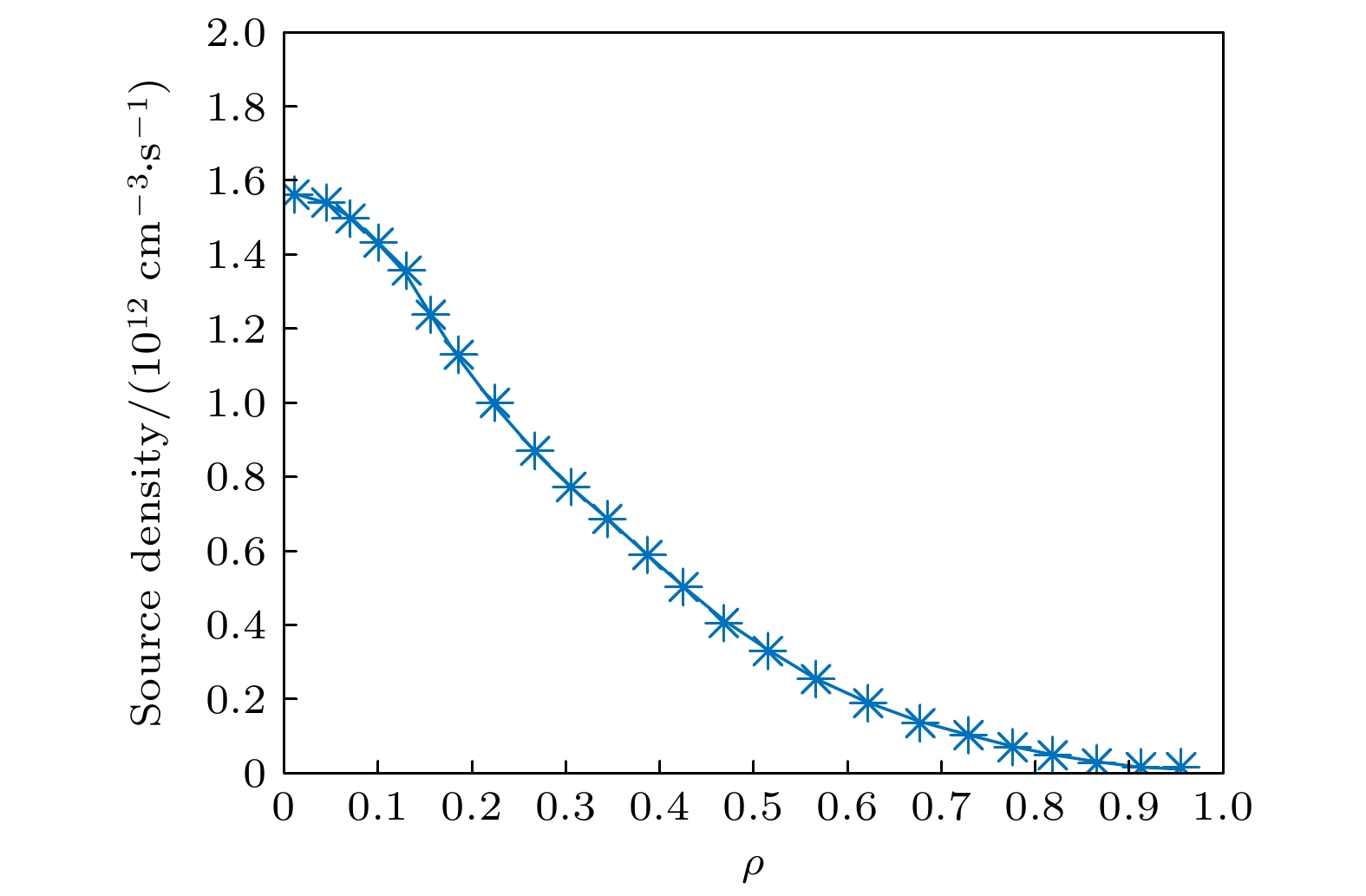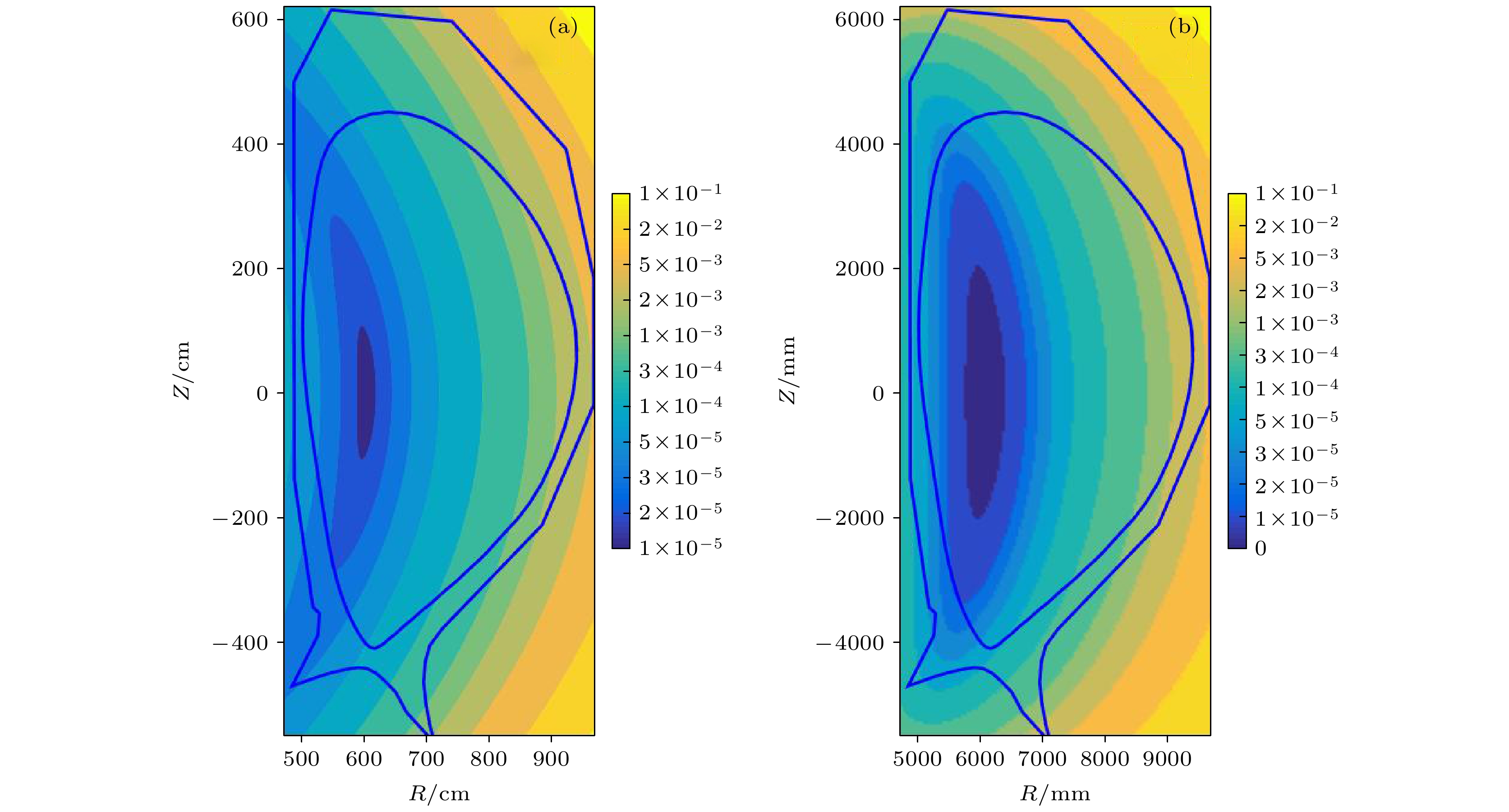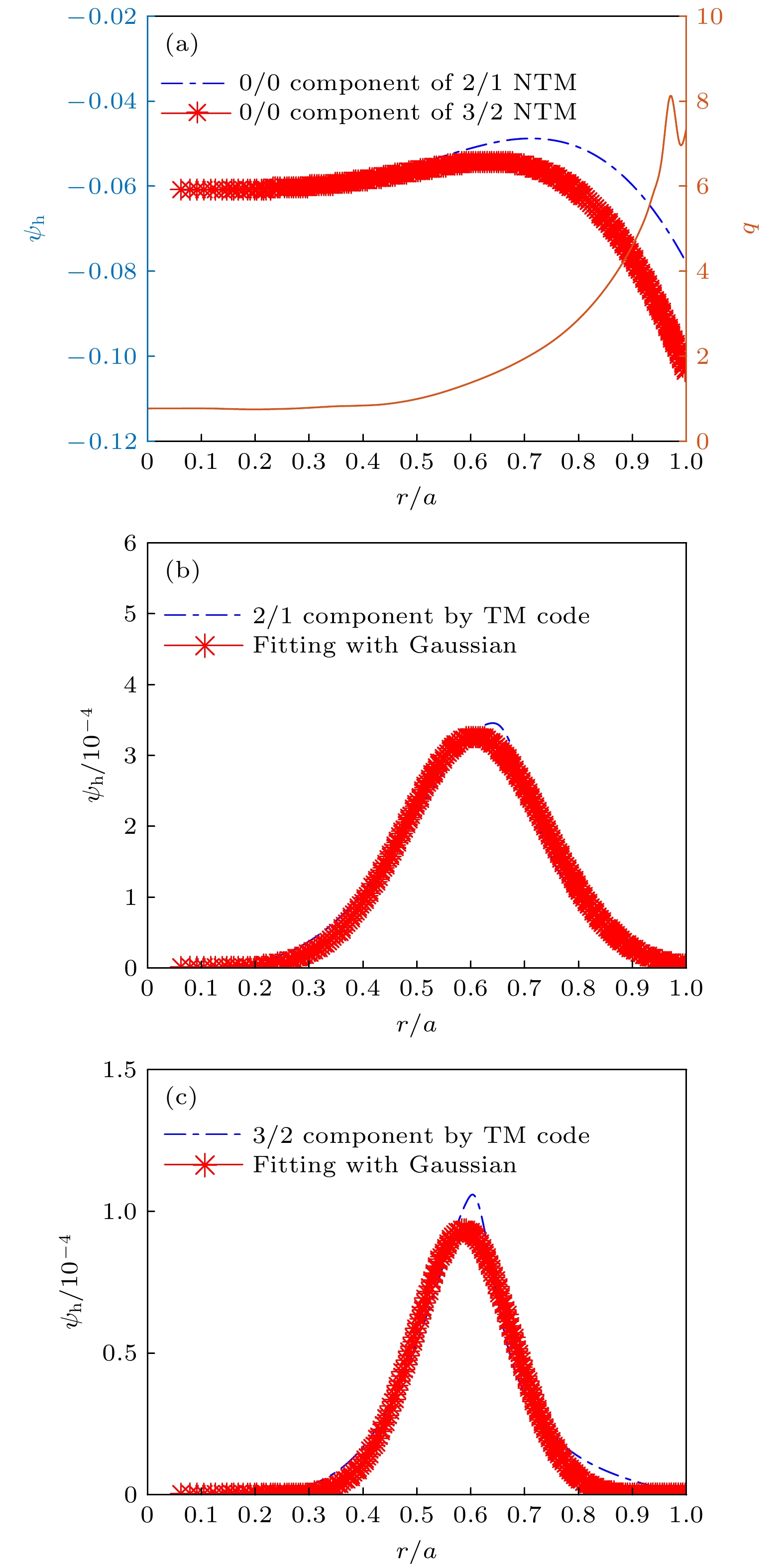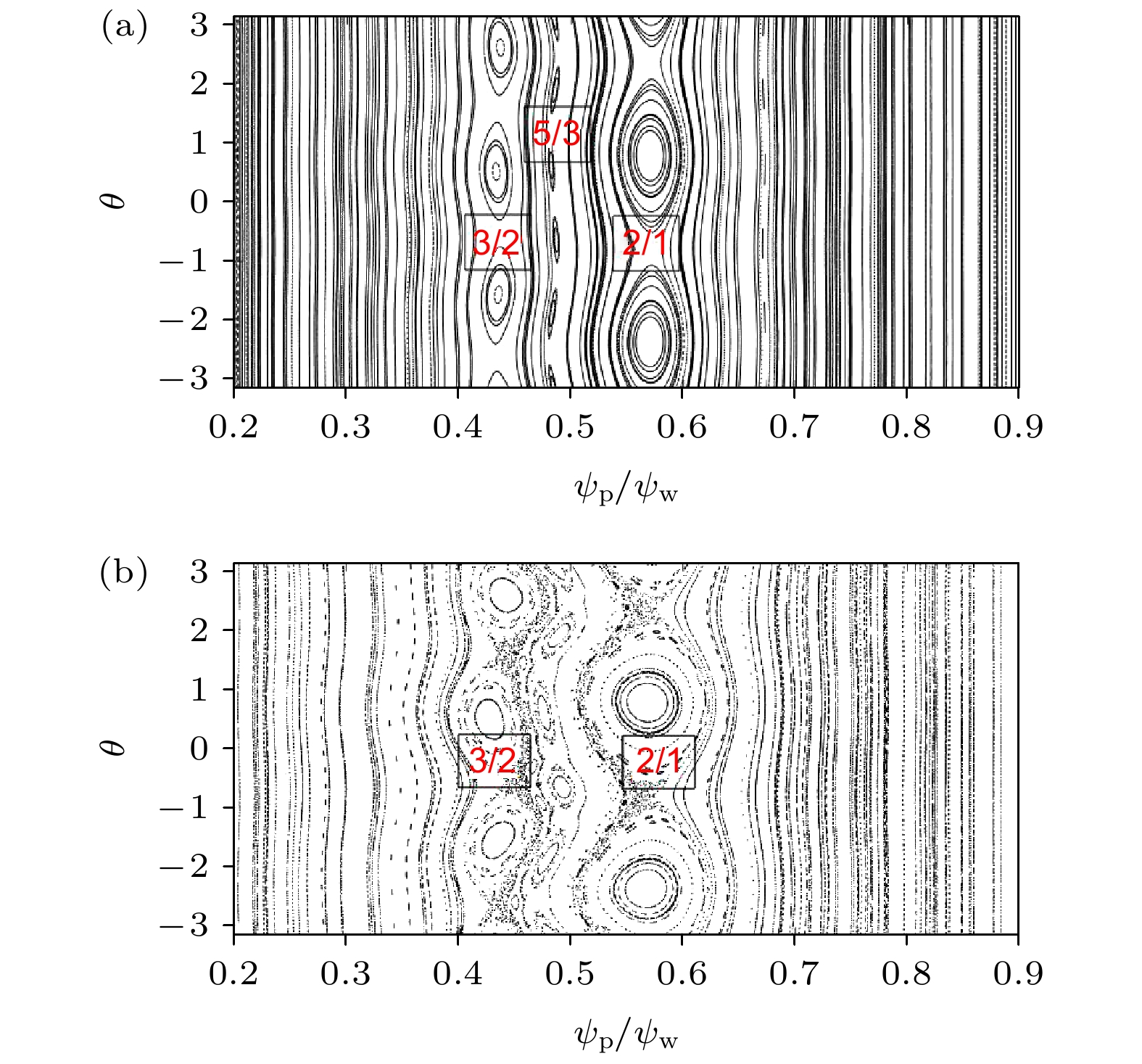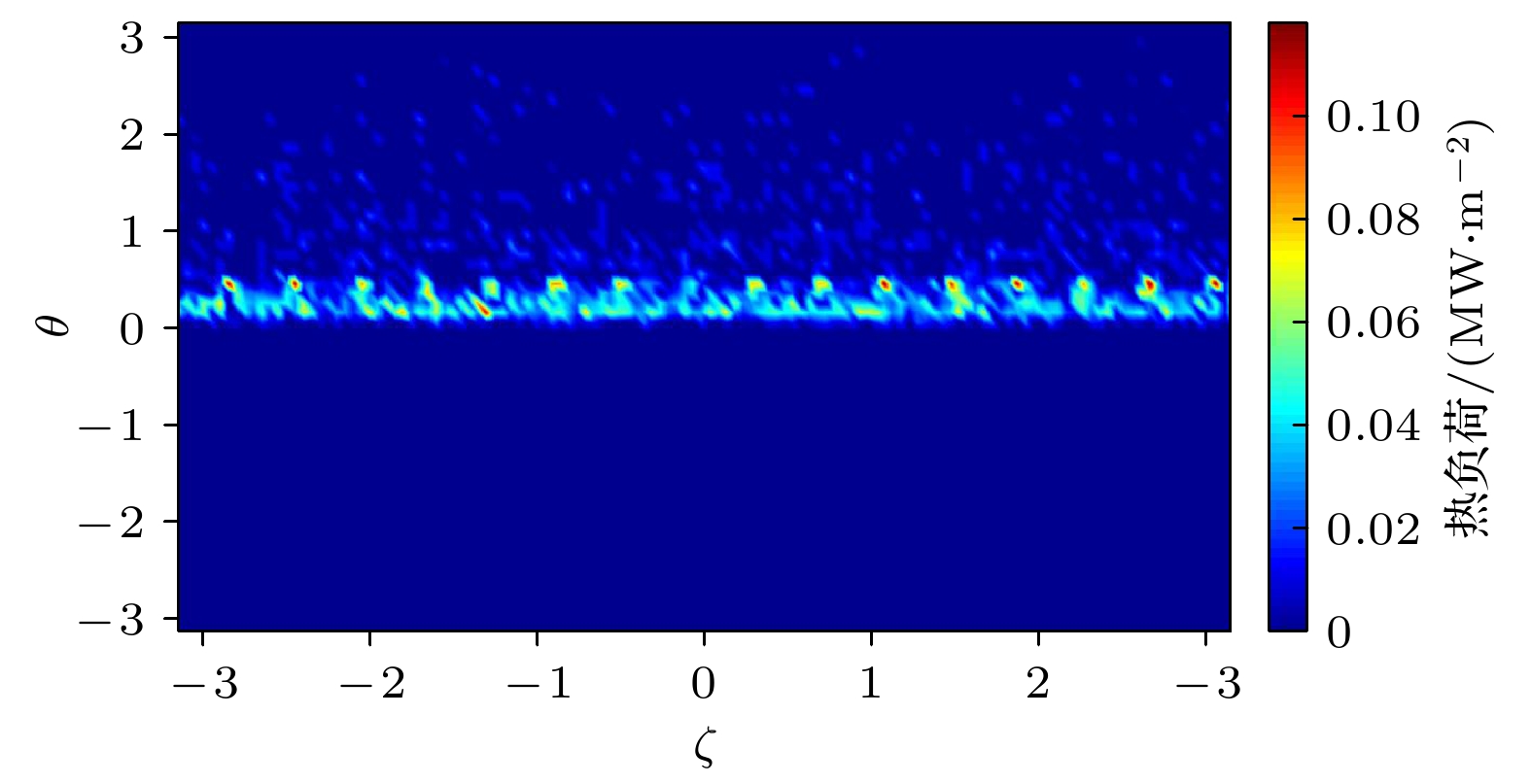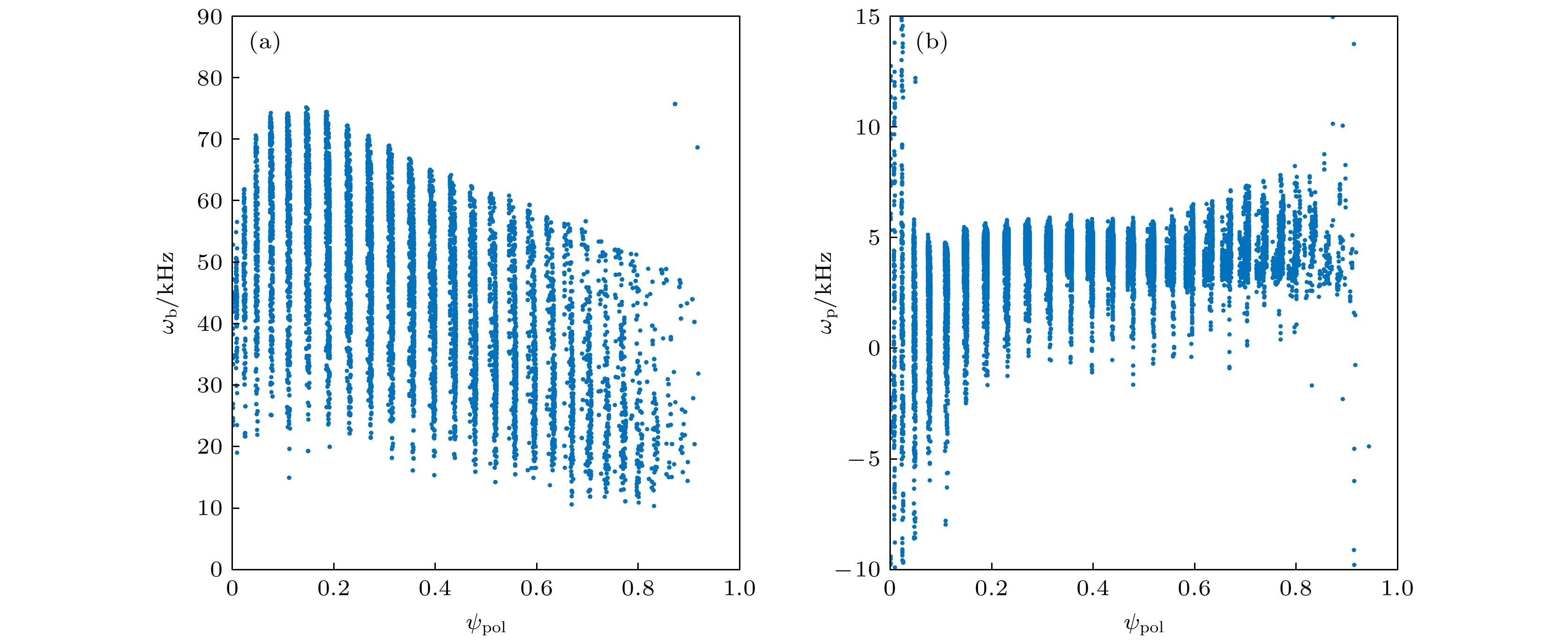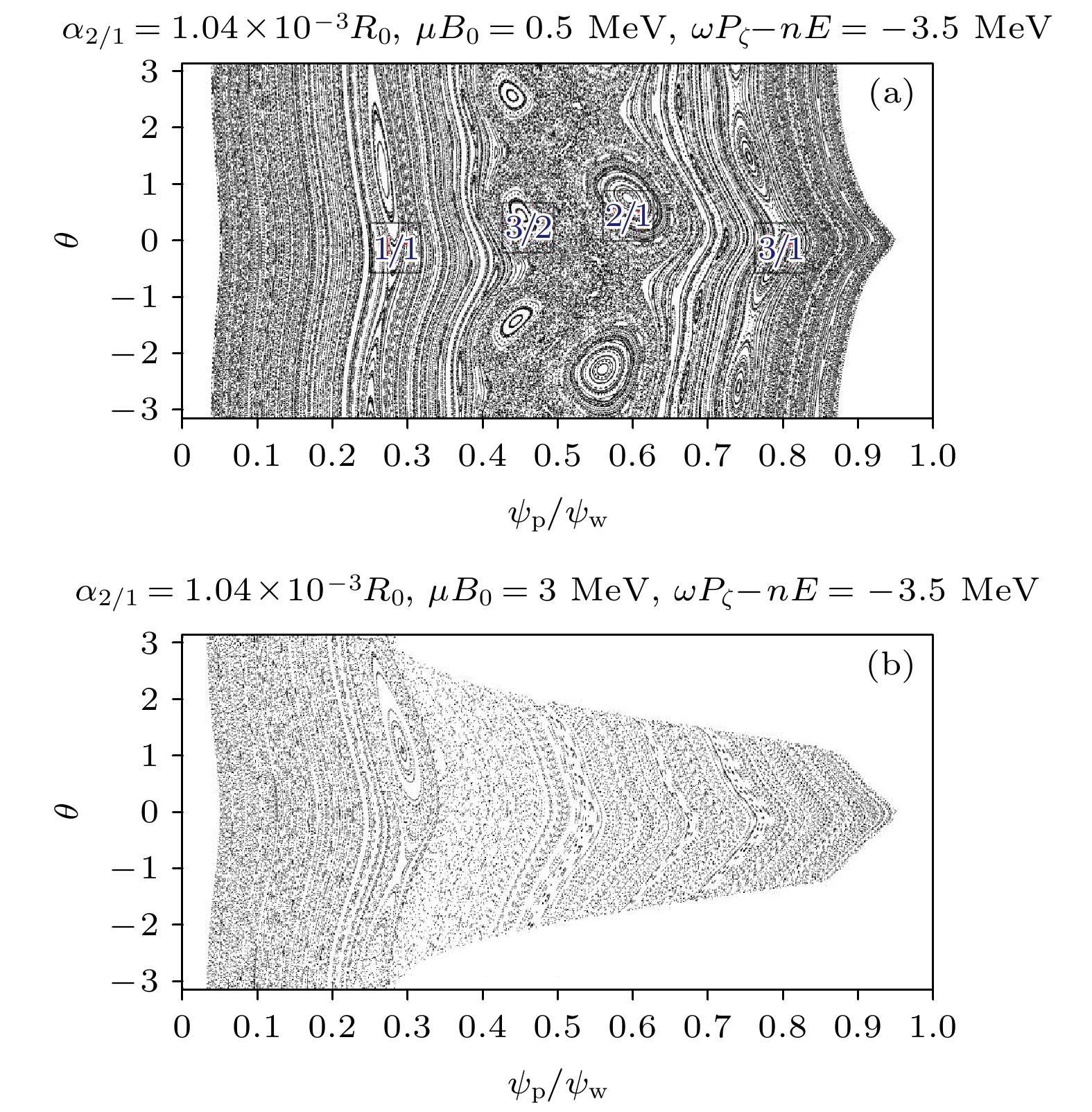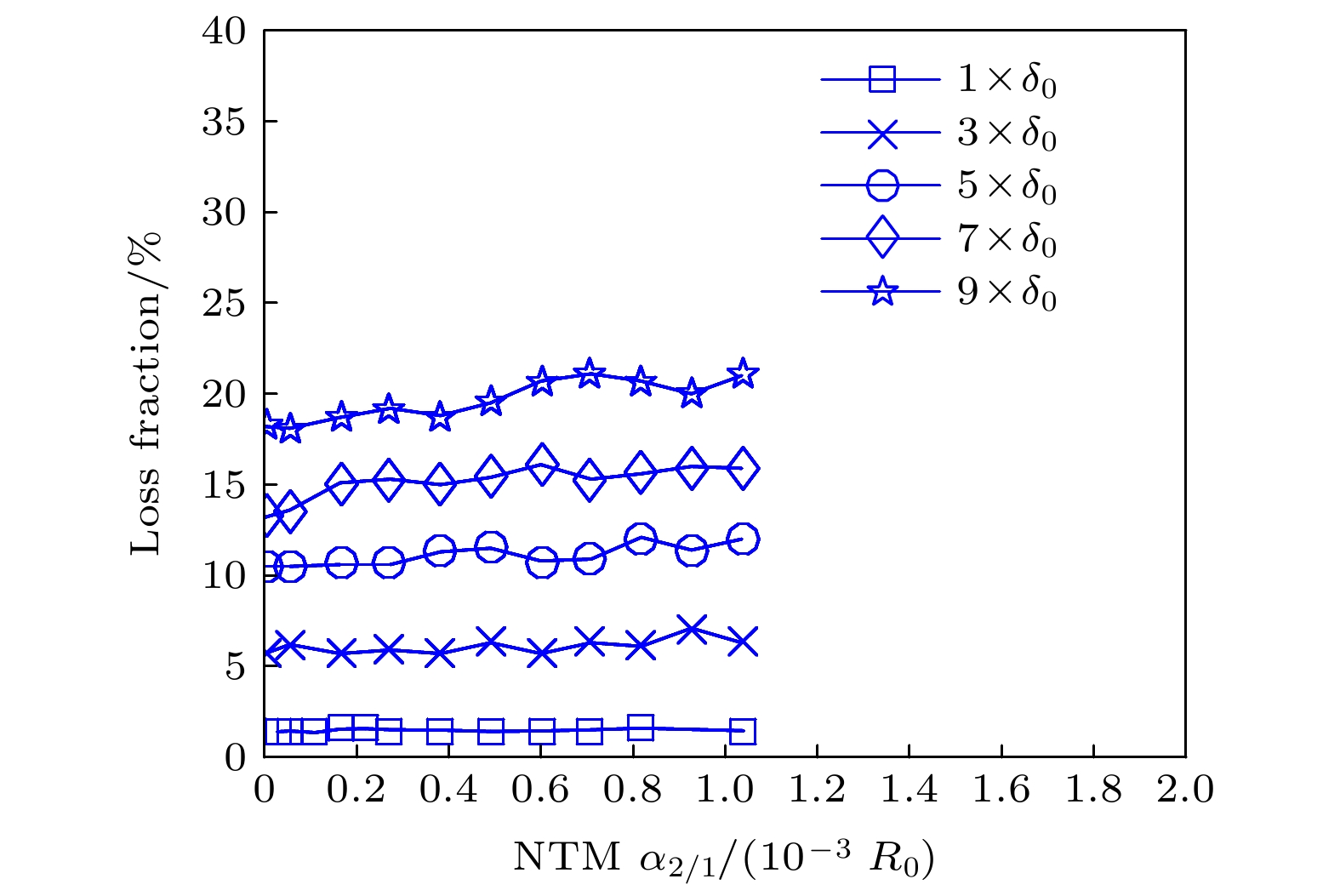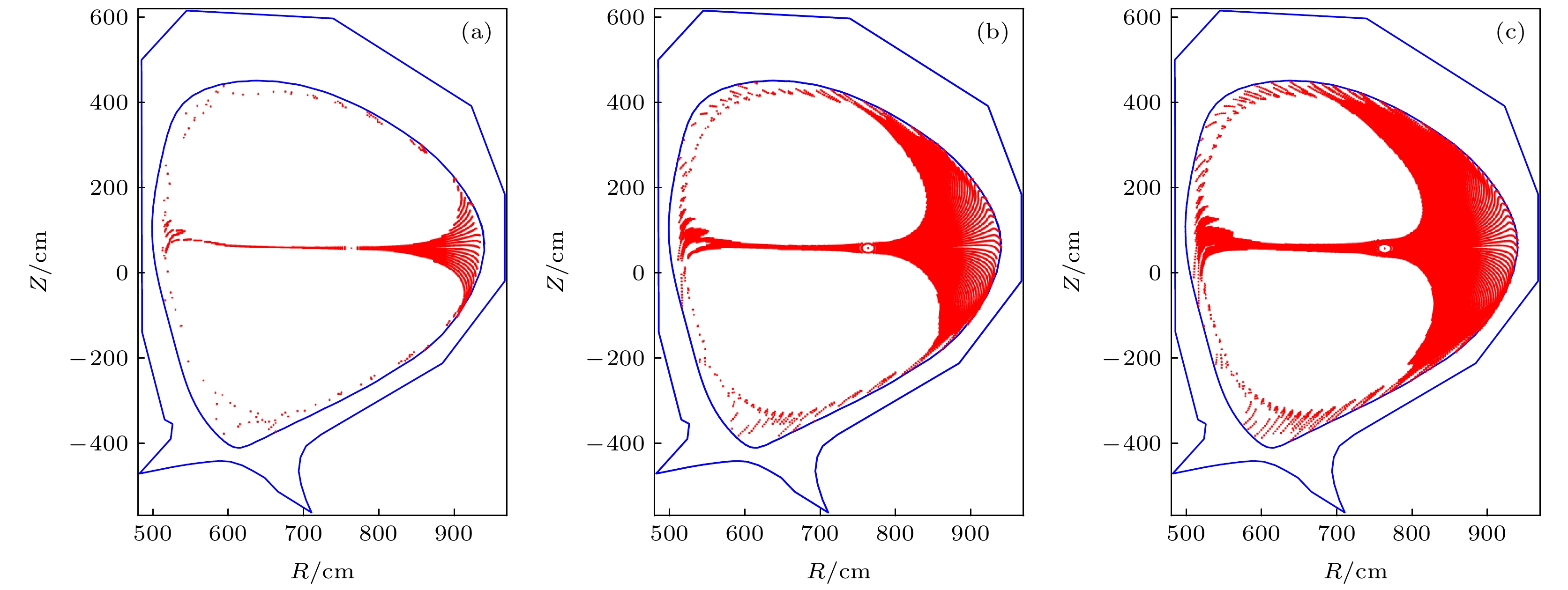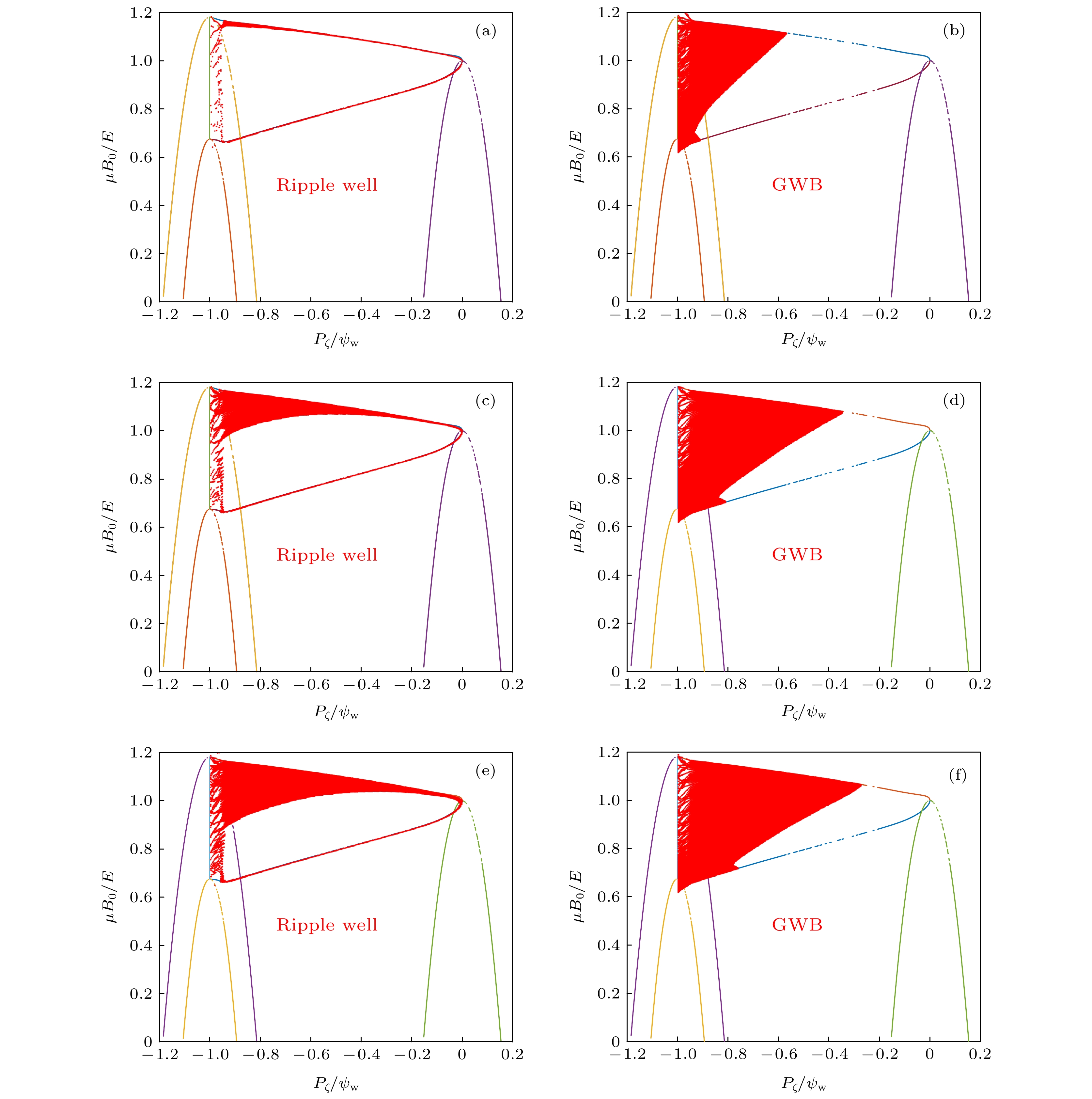-
Confinement of fusion born alpha particles in tokamak is the key issue to burning plasma. Apart from toroidal field ripple, instabilities can induce energetic particles to lose and be redistributed. Based on the parameters of China Fusion Engineering Testing Reactor (CFETT) hybrid scenario, alpha particle distribution and neoclassical tearing mode structure, the alpha particle loss induced under perturbation of ripple and neoclassical tearing mode (NTM) is calculated with the guiding center code ORBIT. The inputs have the initial distribution of alpha particles which is obtained with the TRANSP/NUBEAM code, the static NTM perturbation with different amplitudes which is obtained from TM1 code, and the ripple field from engineering design. The results show that the heat load on last closed flux surface is about 0.1 MW/m2, with ripple and collision included. The collisionless stochastic ripple diffusion is the main loss channel of initial alpha particle distribution in the CFETR, and the ripple perturbation has no influence on passing particles. The loss fraction does not increase with the NTM perturbation amplitude increasing, the synergistic effect is negligible. The scanning of ripple amplitude shows that the synergistic effect is slight. The monoenergetic initial distribution of alpha particles can give different types of orbits in the plane of (
$ {P_\zeta },\mu $ ), such as the domains of trapped particle and passing particle, lost particle and confined particle. The trapped fraction of initial alpha particles is about 27%, ripple loss region in phase space is narrow and away from the main trapped particle distribution. The increasing of ripple perturbation in simulation does enlarge the ripple loss domain in the phase space ($ {P_\zeta },\mu $ ), which is corresponding to a lager ripple loss fraction and has more trapped-passing boundaries. The NTM perturbation does enlarge the orbit excursions of trapped particles, and thus increasing the trapped passing transition near the boundary. The slight synergistic effect in calculation with larger ripple amplitude is explained by ripple loss region having more trapped-passing boundaries, not by the profile flattening of trapped particles. The NTM perturbation and finite collision can transit the passing particle to trapped particle near the boundary. With the help of kinetic Poincare plot, neither direct particle loss nor profile flattening of trapped particles is observed. The loss fraction enhancement can happen only when the profile flattening of trapped particles takes place within the ripple loss region, which is not the case in CFETR. The conclusion of this work contributes a lot to the design of CFETR and the study of alpha particle physics.-
Keywords:
- tokamak /
- alpha particle /
- magnetic ripple /
- neoclassical tearing mode
[1] Zhuang G, Li G Q, Li J, et al. 2019 Nucl. Fusion 59 112010
 Google Scholar
Google Scholar
[2] Wan Y X, Li J, Liu Y, et al. 2017 Nucl. Fusion 57 102009
 Google Scholar
Google Scholar
[3] Chen J, Jian X, Chan V, et al. 2017 Plasma Phys. Controlled Fusion 59 075005
 Google Scholar
Google Scholar
[4] Gorelenkov N N, Pinches S D, Toi K, et al. 2014 Nucl. Fusion 54 125001
 Google Scholar
Google Scholar
[5] Fasoli A, Gormenzano C, Berk H L, et al. 2007 Nucl. Fusion 47 S267
[6] Pinches S D, Chapman I T, Lauber Ph W, et al. 2015 Phys. Plasmas. 22 021807
 Google Scholar
Google Scholar
[7] White R B, Rutherford P H, Colestock P, et al. 1988 Phys. Rev. Lett. 60 2038
 Google Scholar
Google Scholar
[8] Chapman I T 2011 Plasma Phys. Controlled Fusion 53 013001
 Google Scholar
Google Scholar
[9] Igochine V 2015 Active Control of Magneto-hydrodynamic Instabilities in Hot Plasmas (Berlin: Springer) p259
[10] Poli E, Garcia-Munoz M, Fahrbach H, et al. 2008 Phys. Plasmas 15 032501
 Google Scholar
Google Scholar
[11] Gobbin M, Marrelli L, Fahrbach H, et al. 2009 Nucl. Fusion 49 095021
 Google Scholar
Google Scholar
[12] Strumberger E, Gunter S, Schwarz E, et al. 2008 New J. Phys. 10 023017
 Google Scholar
Google Scholar
[13] Garcia-Munoz M, Fahrbach H, Pinches S D, et al. 2009 Nucl. Fusion 49 085014
 Google Scholar
Google Scholar
[14] Garcia-Munoz M, Martin P, Fahrbach H, et al. 2007 Nucl. Fusion 47 L10
 Google Scholar
Google Scholar
[15] Mynick H E 1993 Phys. Fluids B 5 1471
 Google Scholar
Google Scholar
[16] 郝保龙, 陈伟, 蔡辉山, 等 2020 中国科学: 物理学 力学 天文学 50 065201
 Google Scholar
Google Scholar
Hao B L, Chen W, Cai H S, et al. 2020 Sci. Sin. Phys. Mech. Astron. 50 065201
 Google Scholar
Google Scholar
[17] White R B 2014 The theory of toroidally confined plasmas (3th Ed.) (Singapore: World scientific publishing company) p73
[18] Pankin A, McCune D, Andre R, et al. 2004 Computer Physics Communications 159 157
 Google Scholar
Google Scholar
[19] 高翔, 万宝年, 宋云涛, 等 2019 中国科学: 物理学 力学 天文学 49 045202
 Google Scholar
Google Scholar
Gao X, Wan B N, Song Y T, et al. 2019 Sci. Sin.-Phys. Mech. Astron. 49 045202
 Google Scholar
Google Scholar
[20] Yu Q, Gunter S, Scott B D 2003 Phys. Plasmas. 10 798
[21] Wang X J, Yu Q, Zhang X D, et al. 2018 Nucl. Fusion 58 016045
 Google Scholar
Google Scholar
[22] Hao B L, White R B, Gao X, et al. 2019 Nucl. Fusion 59 076040
 Google Scholar
Google Scholar
[23] Wu B, Hao B L, White R B, et al. 2017 Plasma Phys. Controlled Fusion 59 025004
 Google Scholar
Google Scholar
[24] Boozer A H, Kuo-Petravic G 1981 Phys. Fluids 24 851
 Google Scholar
Google Scholar
[25] Zhao R, Wang Z X, Wang F, et al. 2020 Plasma Phys. Controlled Fusion 62 115001
 Google Scholar
Google Scholar
[26] Carolipio E M, Heidbrink W W, Forest C B, et al. 2002 Nucl. Fusion 42 853
 Google Scholar
Google Scholar
-
图 5 固定2/1和3/2模扰动幅度比例下扫描NTM扰动幅度下的庞加莱图 (a)
${\alpha _{2/1}} = 1.64 \times {10^{ - 4}}{R_0}$ ; (b)${\alpha _{2/1}} = l $ $ 6.00 \times {10^{ - 4}}{R_0}$ Figure 5. Poincare plot under different NTM perturbation amplitude with the ratio fixed
${{{\alpha _{2/1}}} / {{\alpha _{3/2}}}} = 4.38$ : (a)${\alpha _{2/1}} = $ $ 1.64 \times {10^{ - 4}}{R_0}$ ; (b)${\alpha _{2/1}} = 6.00 \times {10^{ - 4}}{R_0}$ .表 1 CFETR与其他托卡马克装置主机参数对比
Table 1. Main parameters comparison of CFETR and other tokomak facilities.
参数 CFETR ITER EAST 磁轴场强${B_{{\rm{T}}0}}$/T 6.5 5.3 2 等体大半径${R_0}$/m 7.2 6.2 1.9 等体小半径a/m 2.2 2.0 0.5 等体电流${I_{\rm{p}}}$/MA 14 15 1 纵场磁体柄数N 16 18 16 -
[1] Zhuang G, Li G Q, Li J, et al. 2019 Nucl. Fusion 59 112010
 Google Scholar
Google Scholar
[2] Wan Y X, Li J, Liu Y, et al. 2017 Nucl. Fusion 57 102009
 Google Scholar
Google Scholar
[3] Chen J, Jian X, Chan V, et al. 2017 Plasma Phys. Controlled Fusion 59 075005
 Google Scholar
Google Scholar
[4] Gorelenkov N N, Pinches S D, Toi K, et al. 2014 Nucl. Fusion 54 125001
 Google Scholar
Google Scholar
[5] Fasoli A, Gormenzano C, Berk H L, et al. 2007 Nucl. Fusion 47 S267
[6] Pinches S D, Chapman I T, Lauber Ph W, et al. 2015 Phys. Plasmas. 22 021807
 Google Scholar
Google Scholar
[7] White R B, Rutherford P H, Colestock P, et al. 1988 Phys. Rev. Lett. 60 2038
 Google Scholar
Google Scholar
[8] Chapman I T 2011 Plasma Phys. Controlled Fusion 53 013001
 Google Scholar
Google Scholar
[9] Igochine V 2015 Active Control of Magneto-hydrodynamic Instabilities in Hot Plasmas (Berlin: Springer) p259
[10] Poli E, Garcia-Munoz M, Fahrbach H, et al. 2008 Phys. Plasmas 15 032501
 Google Scholar
Google Scholar
[11] Gobbin M, Marrelli L, Fahrbach H, et al. 2009 Nucl. Fusion 49 095021
 Google Scholar
Google Scholar
[12] Strumberger E, Gunter S, Schwarz E, et al. 2008 New J. Phys. 10 023017
 Google Scholar
Google Scholar
[13] Garcia-Munoz M, Fahrbach H, Pinches S D, et al. 2009 Nucl. Fusion 49 085014
 Google Scholar
Google Scholar
[14] Garcia-Munoz M, Martin P, Fahrbach H, et al. 2007 Nucl. Fusion 47 L10
 Google Scholar
Google Scholar
[15] Mynick H E 1993 Phys. Fluids B 5 1471
 Google Scholar
Google Scholar
[16] 郝保龙, 陈伟, 蔡辉山, 等 2020 中国科学: 物理学 力学 天文学 50 065201
 Google Scholar
Google Scholar
Hao B L, Chen W, Cai H S, et al. 2020 Sci. Sin. Phys. Mech. Astron. 50 065201
 Google Scholar
Google Scholar
[17] White R B 2014 The theory of toroidally confined plasmas (3th Ed.) (Singapore: World scientific publishing company) p73
[18] Pankin A, McCune D, Andre R, et al. 2004 Computer Physics Communications 159 157
 Google Scholar
Google Scholar
[19] 高翔, 万宝年, 宋云涛, 等 2019 中国科学: 物理学 力学 天文学 49 045202
 Google Scholar
Google Scholar
Gao X, Wan B N, Song Y T, et al. 2019 Sci. Sin.-Phys. Mech. Astron. 49 045202
 Google Scholar
Google Scholar
[20] Yu Q, Gunter S, Scott B D 2003 Phys. Plasmas. 10 798
[21] Wang X J, Yu Q, Zhang X D, et al. 2018 Nucl. Fusion 58 016045
 Google Scholar
Google Scholar
[22] Hao B L, White R B, Gao X, et al. 2019 Nucl. Fusion 59 076040
 Google Scholar
Google Scholar
[23] Wu B, Hao B L, White R B, et al. 2017 Plasma Phys. Controlled Fusion 59 025004
 Google Scholar
Google Scholar
[24] Boozer A H, Kuo-Petravic G 1981 Phys. Fluids 24 851
 Google Scholar
Google Scholar
[25] Zhao R, Wang Z X, Wang F, et al. 2020 Plasma Phys. Controlled Fusion 62 115001
 Google Scholar
Google Scholar
[26] Carolipio E M, Heidbrink W W, Forest C B, et al. 2002 Nucl. Fusion 42 853
 Google Scholar
Google Scholar
Catalog
Metrics
- Abstract views: 3563
- PDF Downloads: 58
- Cited By: 0















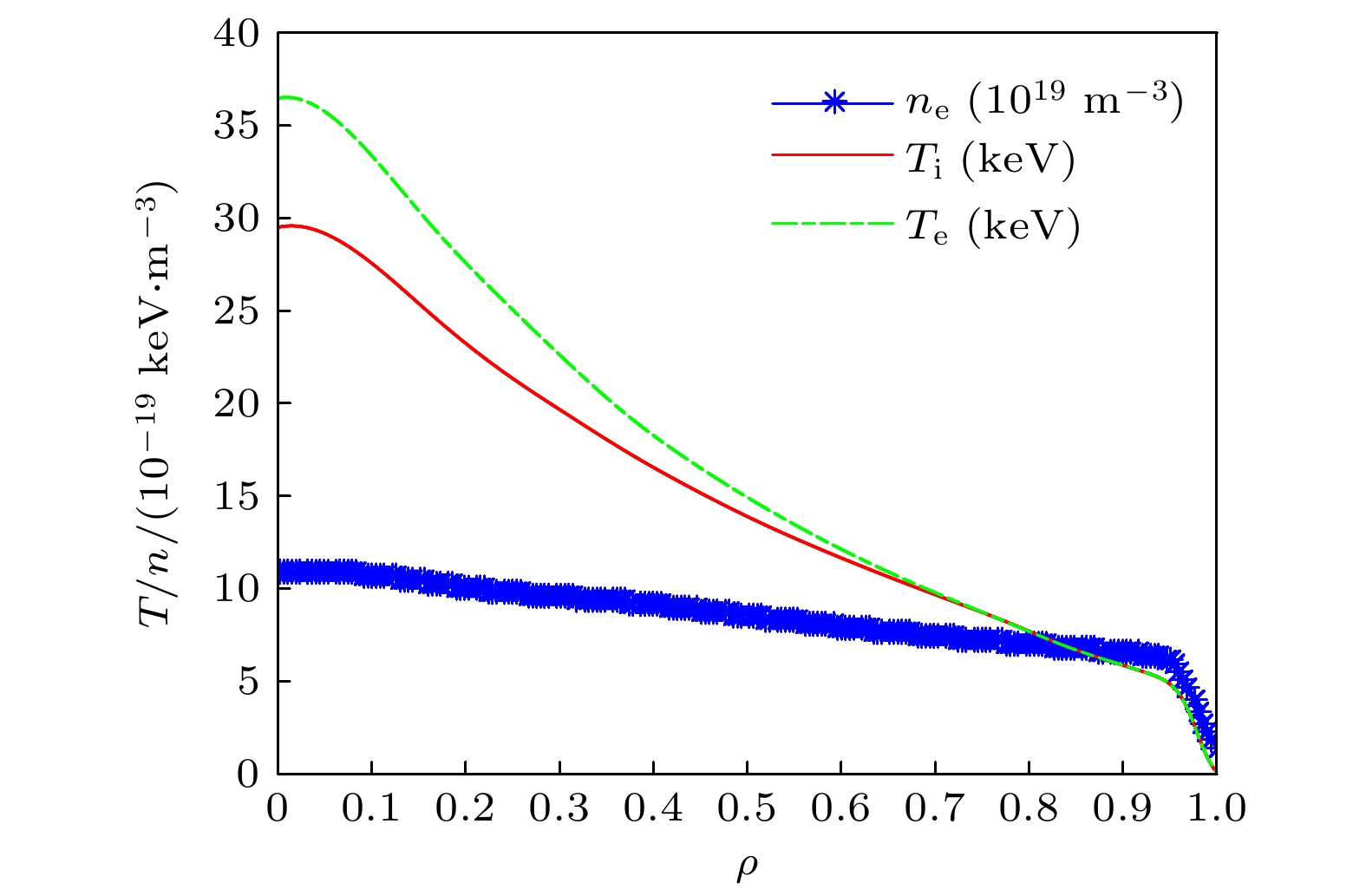
 DownLoad:
DownLoad:
